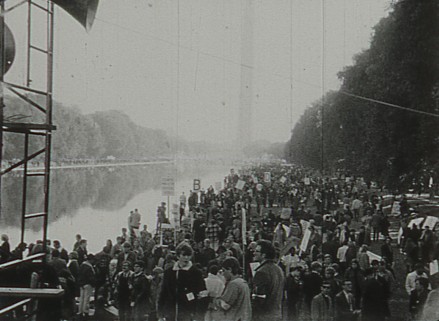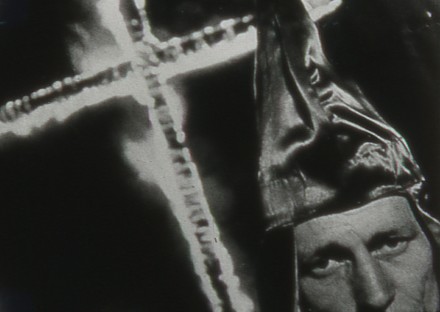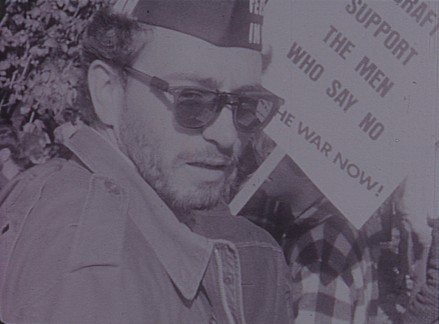
Before Newsreel: Documenting Antiwar Protests on the East Coast
Films
- Read More
 Documentary
DocumentaryPentagon Protest
Harry Weisburd16mm, black and white, sound, 13 minRental format: 16mm - Read More
 Documentary
DocumentarySaturday 4/15/67
Harry Weisburd16mm, black and white, sound, 26.5 minRental format: 16mm - Read More
 DocumentaryExperimental
DocumentaryExperimentalMarch on the Pentagon
David Ringo16mm, black and white, sound, 20.5 minRental format: 16mm
Description
For the second screening in our multi-program series FILMS FOR SOCIAL CHANGE: REVISITED AND EXPANDED, join us at the FMC Screening Room (475 Park Avenue South, 6th Floor) on March 4th, 2024, at 7pm, for four films chronicling anti-Vietnam war efforts on the East Coast.
In the Fall of 1966, a group of activists and antiwar political figures met in Cleaveland to form an organizing committee to demonstrate publicly and apply pressure politically to end the then-raging War in Vietnam. The committee would eventually be renamed The National Mobilizing Committee to End the War in Vietnam (or The Mobe). The group counted among its members and associates key and transformative figures and groups in the antiwar, civil rights, and the burgeoning New Left movements: James Bevel, Stew Albert, Rennie Davis, David Dellinger, Robert Greenblatt, Tom Hayden, Dr. Martin Luther King Jr., Coretta Scott King, Fred Halstead, Bradford Lyttle, A. J. Muste, Sidney Peck, Charles Owen Rice, Jerry Rubin, Dr. Benjamin Spock and SANE, Vietnam Summer, Karen Wald, and Eric Weinberger.
On April 15, 1967, according to contemporary reports, some 400,000 people gathered in the Sheep Meadow on the Western side of Central Park and marched to the U.N. to decry the War. They heard speeches from James Bevel, Harry Belafonte, and Martin Luther King Jr. A simultaneous march occurred in San Franciso with speeches by Black Panther leader Eldridge Cleaver and Julian Bond, founder of the Student Nonviolent Coordinating Committee and later the Southern Poverty Law Center. It was the first major public demonstration against the US’s involvement in Vietnam. The events were soon overshadowed nationally by the later March on the Pentagon, but the event in New York was more substantial, and like its later counterpart, began to firm up the alliance between cultural expression and pollical dissent. Three months before the April march, the large, New York-based collective The Week of Angry Arts had already staged scores of events, including the screening of a 60-film compilation of responses to the war by a range of prominent experimental filmmakers and artists entitled For Life, Against the War, and the unveiling of an equally ambitious Collage of Dissent, a ten by six foot mural of collages by 150 artists at the Loeb Student Center at New York University. Continuing this tradition of cultural activism, Harry Weisburd’s Saturday 4/15/67 documented the March, but instead of offering up direct unexpurgated footage, he precedes his in-person account with a quicksilver collage of news coverage and politicking that places the film in a dada-esque agitprop tradition much like the efforts of his colleagues in The Angry Arts group (who coincidently can be seen marching with a banner in the second part of the film).
Though perhaps better known in the wider culture as the backdrop of Norman Mailer’s nonfiction novel Armies of The Night (1968), the Mobe-organized March on the Pentagon on October 21, 1967 also spurred such hippie-era cliches as National Guard rifles being plugged by flowers, and saw a mass chant led by Allen Ginsberg; soon-to-be Yippies Jerry Rubin and Abbie Hoffman and the Fugs to exorcise the miltary-industrical complex from the American psyche as well as ‘levitate the Pentagon’. The demonstration is considered a significant turning point in the history of dissent against the war, with the incorporation of artistic and cultural gestures coming to the fore, but also a more staunch and violent resistance from the authorities, setting the stage for clashes that would begin to dominate the divided body politics in the coming years. As the evening progressed and a gap in the police and military line guarding the Pentagon was breached, the protests turned violent. According to Todd Gitlin, Executives at CBS had captured footage of the heavy-handed police actions against demonstrators but stopped the footage from airing and encouraged other networks to do so. Due to the sheer number of artists and filmmakers in the antiwar movement, there was a significant amount of on the ground, eyewitness footage shot of the events.
A number of these individual figures quickly came together in New York at the then offices of the Film-Makers’ Cooperative to form a group that would provide an alternative to the occlusion and sanitizing of such events in the mainstream media. They called themselves Newsreel. Their film No Game compiled footage by filmmakers including Marvin Fishman, Norm Fruchter, Peter Gessner, Robert Kramer, Robet Machover, Masanori Oe, and Allan Siegel. Work on the film that edited together the disparate footage was completed by Fishman and Oe. The film’s raw collision of sound and image gives the work a rough-hewn feel that is as much aurally cacophonous as it is visually dynamic. The film uses sound in a noteworthy way as a dense form of collage that privileges not one singular voice but a multitude of shouts, chants, calls, and responses to both give the effect of verisimilitude but also render in cinematic form the collective nature of the struggle at hand. This is the result of the films being made quickly and cheaply, without quality synch-sound equipment, but also fed the agenda of Newsreel in their commitment to making films ‘from within the situations they present from the point of view of the people’.
The Coop’s collection also contains two further films that bear witness to the events of that day that have been rarely screened and were not incorporated into any later compilations: David Ringo’s March on the Pentagon and Harry Weisburd’s Pentagon Protest. Weisburd’s film mainly depicts the very early afternoon of the rally outside the Lincoln Memorial and captures on its soundtrack the majority of comedian and civil rights activist, Dick Gregory’s impassioned speech. The loose quality of the film sets it apart from the more rigorous dualistic composition of Weisburd’s film on the New York protests earlier in the year. Ringo’s film is an incisive document of the day; it has an intriguing, people-less opening that almost abstractly displays the streets of a deserted New Haven, CT. Ringo cuts frantically between shots of wheatpasted bills advertising the Pentagon March to the City’s student body (in many instances these notices are defaced, rendered illegible by markings and tearings, reflective of the then-ambivalent public feeling towards antiwar sentiment among young people); on the film’s soundtrack we hear a group of protests aboard a bus as they begin to prepare for the events of October 21st. This more formally audacious opening is followed by impromptu verité footage of the rest of the day. Unlike the other films presented here, Ringo insisted that the work was a humanist portrait, that sought to demonstrate that the citizens who vehemently opposed the war were everyday people, not militants or leftist insurgents: ‘It is not a news film’ he wrote in the film’s press release, ‘it is not a propaganda film, it is not an objective or analytical film. It was made with the conviction that the people of the demonstration, their feelings, faces, and reactions are as important as the events of the day’. This genteel perspective is perhaps undercut by the reality of the protests and the birth of a new era, telegraphed by the March on the Pentagon, that saw new waves of oppression and violence meeting the resistance. These are actions that will be explored in two later programs in this series: The Elysian Park Love-In and The Destruction of the People’s Park and Chicago 1968.
*This program also includes the film No Game by Newsreel (black and white, sound, 16 minutes).*